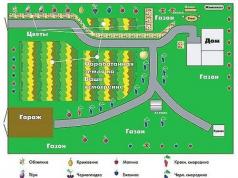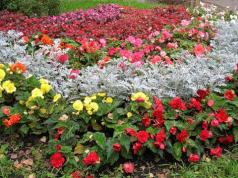Many different berries grow in our gardens. These are gooseberries and currants, strawberries and strawberries, raspberries and blackberries. But there are no limits to perfection: for the garden to be complete, you want to grow all new crops, please the eye and taste with them. For those who dream about it, there is a new variety of berries - ezhemalina. Yes, you are not mistaken, this is a hybrid of raspberries and blackberries. It would seem, why is it needed if there are ordinary berries? And in order to please you with large harvests, beautiful views and many other benefits. Are you intrigued? Well, then it's worth learning more about this interesting berry so that you can start cultivating it next season.
Most often, the hybrid is described by comparison with raspberries. Ezhemalin tastes like both berries, but, regardless of the variety, it is always sour. Some gardeners don't like this, but other benefits make up for this quality.
- First, ezhemalina is much larger than regular raspberries.
- Secondly, the bushes delight gardeners with excellent harvests, abundant and generous.
- Thirdly, the plant does not require special care. Compared to raspberries, it takes less time and effort to grow a hybrid.
Ezhemalina is also called the logan berry. It comes from America, namely from the California city of Santa Cruz. In the garden of one judge, whose last name was just Logan, two long-known and popular berries, raspberries and blackberries, were accidentally crossed. This is how the ezhemalina or logan berry appeared, as our famous scientist Michurin called it.
Varieties of garden ezhemalina with photo
Today, ezemalina is a berry, which has many varieties that differ in the qualities of bushes, sizes, taste of berries, etc. It is worth considering some of the varieties in order to better understand the question of what is ezemalina.
 Tayberry variety
Tayberry variety This variety was bred by breeders not so long ago. Its main characteristic is its excellent yield. The plants themselves are quite thorny, and the berries have a dark red tint, large in size.
 Loganberry variety
Loganberry variety Feature - the absence of thorns and creeping branches, like a blackberry. The berries are red in color, but when ripe they darken significantly. One piece can weigh up to 5 g and reach more than 3.5 cm in length. Sourness is also present in the taste, ripening occurs early.
 Boysenberry variety
Boysenberry variety This variety is also characterized by creeping bushes. The variety represents different plant forms - thornless and thornless. The berries are oval in shape, large enough, brownish in color. Their taste is closer to blackberries than to raspberries.
 Variety Texas
Variety Texas This variety is characterized by very large berries - up to 12 g in weight. They are elongated. The bush grows up to 5 m, but it does not stretch in height, but spreads. The plant tolerates frost well, especially when compared to other varieties. There are thorns on the bushes. The berries are more like raspberries, their taste is sweetish with sourness.
 Darrow variety
Darrow variety And this variety is already growing upward, reaching 3 m in length. It tolerates frost perfectly, has thorns. From a sufficiently mature plant, about 5 years old, up to 10 kg of the crop can be removed. Sweet and sour berries are medium in size, weighing up to 4 g.
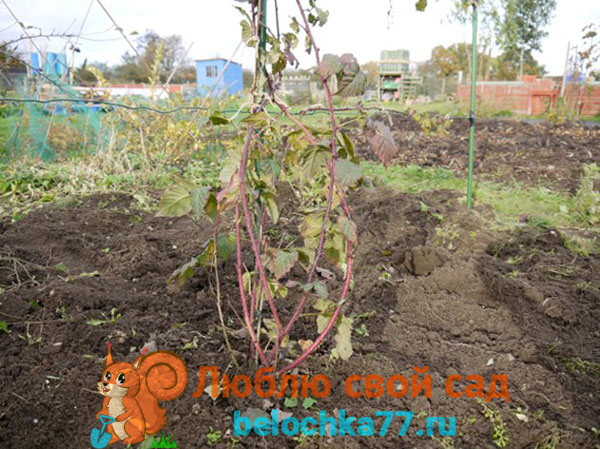
Ezhemalina is planted at the same time as most of the bushes. This plant has special requirements. It is believed that even in summer, bushes can be planted, but not in extreme heat. Ezhemalina is characterized by good survival rate, tolerates different weather conditions. The main thing is to follow the general planting rules at different times of the year.
In spring, the bushes should not yet fully wake up. And in the fall, you need to have time to plant them some time before the onset of frost, so that they have time to take root. Many gardeners point out that it is quite easy to plant the ezemalina and in most cases it takes root well.
Ezhemalina garden: planting and care - 5 golden rules
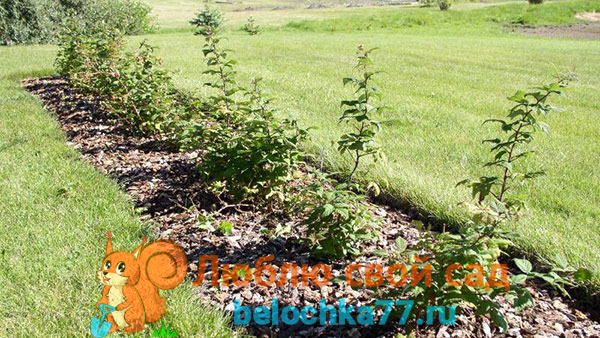
If your seedlings already have vegetative material, it is very important not to damage it. Therefore, the planting is done with great care, the earthen lump is preserved to the maximum.
Like raspberries, it is recommended to plant raspberries in rows. It is necessary to leave at least 0.7-1 m between the bushes. The rows are made at a distance of 1.5-2 m from each other. With this method, a large space is occupied. But this is necessary in order for a sufficient amount of light to hit the plants and fruits. Simply put, if you want a big harvest, do not spare space on the site.
Each pit for planting should be 40x40x40 cm in size. The soil that is extracted during excavation must be mixed with humus.
Note! If you do not have humus, then you should not rush to replace it with other fertilizers - chicken droppings, manure.
The fact is that all organic fertilizers tend to enhance growth. But at the same time, resistance to cold is significantly lost. This is bad for the bushes in the first year after planting. The plant is already weakened during the rooting period, it is more difficult for it to survive the winter.
When everything is ready, you can start planting. The roots of the seedling must be well spread, placed neatly in the hole. From above, they are covered with soil prepared in advance. We complete the planting with good compaction of the soil under the plants and abundant watering.
Remember! Mulching is one of the main secrets of good care for your jemalina. Immediately after planting, you need to put a layer of good mulch under the bushes. It can be used as a dry mullein, rotten sawdust mixed with ash, even weeds. To prevent the latter from growing under the bushes, experts recommend laying corrugated cardboard under the mulch. The total layer should be between 8 and 15 cm.

As mentioned earlier, ezemalina is much less demanding than, for example, raspberries. This also applies to watering. It takes place immediately after landing. And also a few days after pruning. In summer, it is recommended to water the plants only in very dry periods. Most of all, the bushes need moisture during the ripening period of the berries, as well as during their formation. If in the summertime the rains regularly water the ground, although not too often, then additional watering is not required.
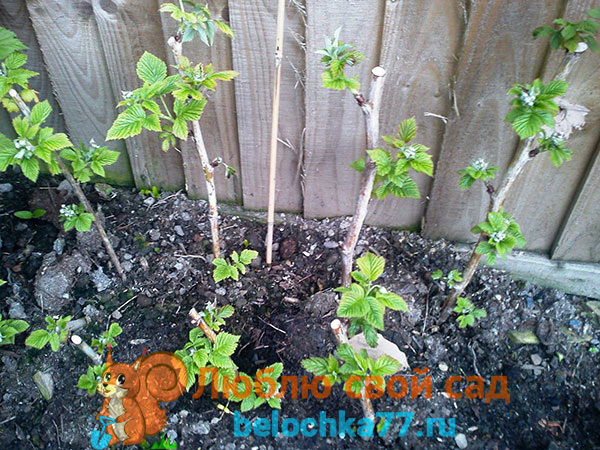
Immediately after planting, there is no need to rush to feed the bushes. According to the advice of experts, the first fertilization is done only 2 years after the rooting of the plants. There are no special programs for blackberries. But for her, the terms, methods and substances that are used for raspberry bushes are quite suitable. Thus, feeding ezmalina is done as follows. It is recommended to apply the necessary substances under the plants approximately once every 2-3 years. We use the following fertilizers:
- Manure - 3-5 kg per 1 m 2;
- Phosphate, potash fertilizers: 2 kg of double superphosphate, 2 kg of potassium sulfate or 5 kg of simple superphosphate per 100 m 2.
Remember! These doses are approximate. They are adjusted depending on the composition of the soil in a particular place.

It is imperative to form ezhemalina bushes, the yield of the plant depends on it. Gardeners disagree about when pruning should be done. It is believed that the best period is late autumn. Some say that it is necessary to prune the shrub after the end of fruiting. Considering that in many regions, ezhemalina bears fruit until the very frost, both of these opinions can be considered correct.
It is not forbidden to carry out pruning in the spring. This is done before the start of sap flow. The activities for the formation of the bushes of the jagged tree include pinching the tops of the bushes, which allows them to grow.
Garter
Many varieties of ezemalina spread strongly, in addition, their berries are quite large and heavy. Therefore, the bushes are recommended to be grown on a trellis or, more simply, they need to be tied up. Do not use simple stakes for this. After all, over time, the bushes still begin to creep, and the berries become smaller. The best option is the tapestry. You can make it single-plane, rather high, about 2-2.5 m. Wire or thick nylon fishing line is pulled in 5 layers. Shoots are tied to the upper layers, which should bear fruit. They are attached with a snake. The rest of the branches are attached to the lower layers.
Such a care measure promotes good growth of the bushes. At the same time, the upper "berry" shoots receive enough light and heat from the sun.

Most often, ezemalina bushes are propagated by vegetative methods. To do this, use:
- Green cuttings. Sometimes the tops are even taken, which are removed when pinching annual shoots. In August, you need to prepare such branches, cutting off 20-35 cm tops. Then they are planted in the ground, deepening by about 20 cm. By the next year, up to 4 real plants can be obtained from such cuttings.
- Lignified cuttings.
- Root cuttings. To obtain them, it is necessary to dig out the roots in the spring and select those that have reached 5-7 mm. They are divided into 15 cm pieces, after which they are planted in rows at a shallow depth - up to 20 cm.
For reproduction with ordinary cuttings, you need to prepare them in the fall, choosing branches of 20 cm each, on which there are at least 2-4 buds. For a day, the workpieces are soaked in water, after which they are planted after 5-10 cm to a depth of 20 cm. There should be no more than 2 buds on the surface. If there is more after watering and subsidence of the soil, then the earth needs to be poured.
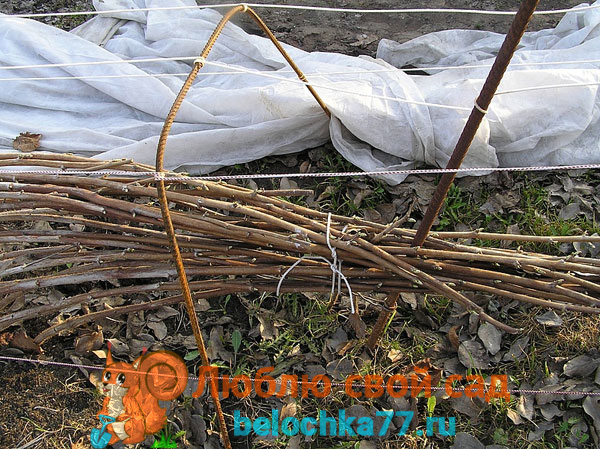
Ezhemalina belongs to shrubs that tolerate cold well. But, despite the frost resistance, it is still worth carrying out some procedures in the fall, because winters are different. First, all branches must be untied from the trellis. They are carefully laid along the supports so as not to damage or break.
For regions with little snowy winters, it is recommended to use an organic shelter - peat, sawdust, fallen leaves or straw. It will protect the shoots from severe frosts. But regions with abundant snowfalls and a large snow cover make it possible not to shelter the jemalin. The snow itself will serve as a "blanket", which will protect the shoots of the bush from freezing.
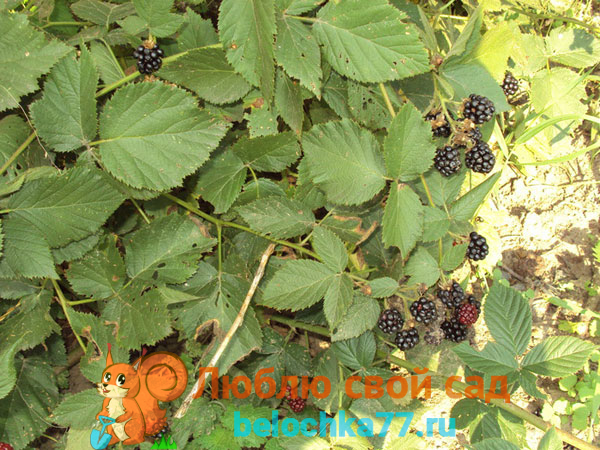
Ezhemalina suffers from the same diseases as regular raspberries. But the hybrid is much more stable, which is another advantage. The following diseases can affect the shrub:
- Powdery mildew;
- Raspberry rust;
- Verticillary wilting, etc.
Interestingly, different varieties are more resistant to a particular disease. While Youngberry and Longaberry are more likely to suffer from rust, then Boysen's berry is resistant to it. At the same time, Longaberry practically does not suffer from powdery mildew or verticillosis, while Boysenberry and Youngberry are affected by them.
There are not so many pests in the bush. These include some insects - weevil, raspberry beetle, galitsa. To avoid an attack, it is worth observing the planting density, mulching the soil, and taking good care of the bushes.

Jemalina berries have a rich chemical composition, which makes them useful for the human body. Anti-inflammatory and antipyretic properties cause the use of berries for acute respiratory infections, fever and pneumonia. Yezemalin has a positive effect on the intestines, nervous system, joints and kidneys. The berry is useful for alcohol or heavy metal poisoning, for cystitis. By the way, not only berries are able to bring benefits, but also to pour, bush branches.
However, there are also contraindications for the hybrid berry. Juice from it can not be drunk by those who suffer from acidity, gastritis, ulcers. Urolithiasis, gout, kidney disease and diabetes mellitus, as well as nasal polyps and bronchial asthma are all diseases in which it is recommended not to abuse ezemalina. The risk of an allergic reaction determines the careful use of the berry for allergy sufferers and pregnant women.
Ezhemalina: video
The hybrid berry ezhemalin is not yet very popular in our area. But only because few people know about it. It is worth cultivating this shrub for many reasons: the plant is not demanding, it brings a rich harvest and is very beneficial to health.

